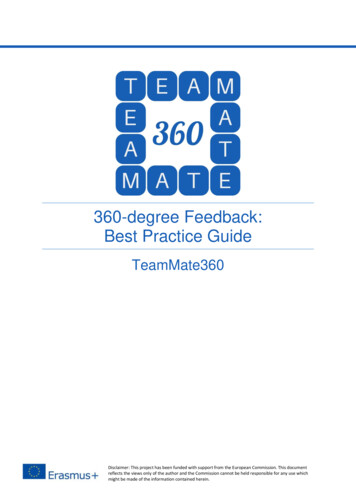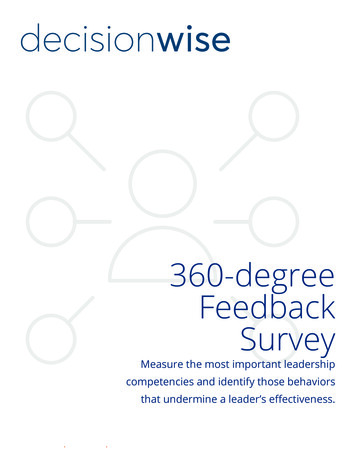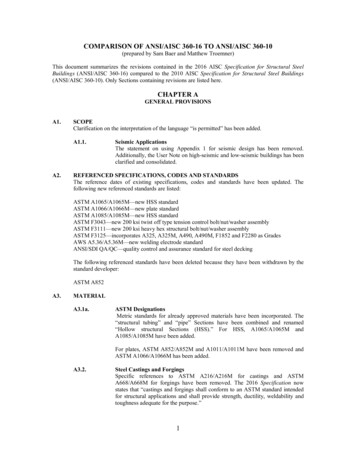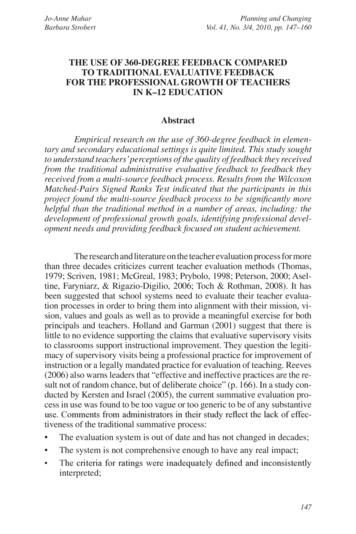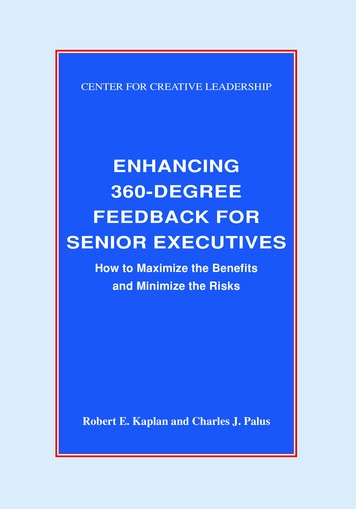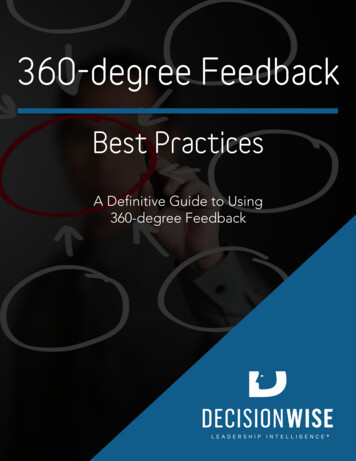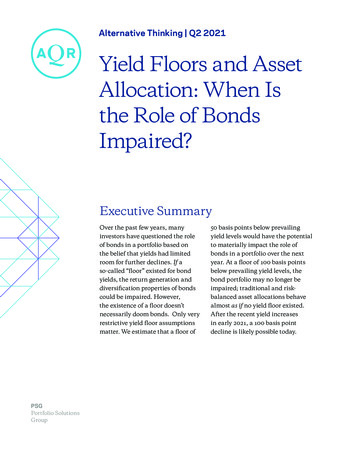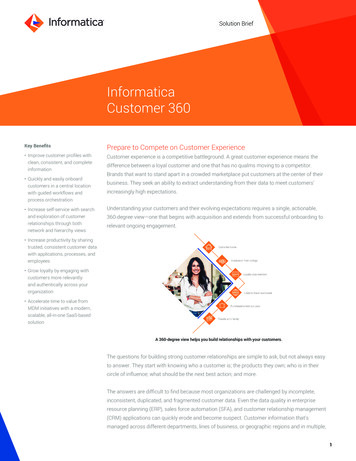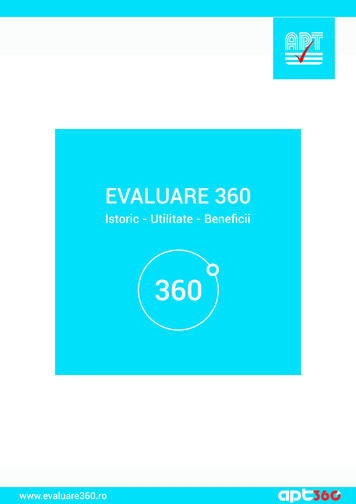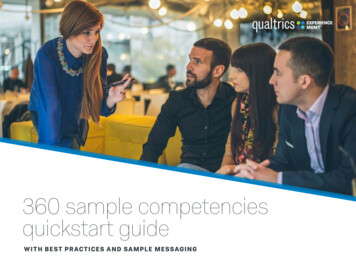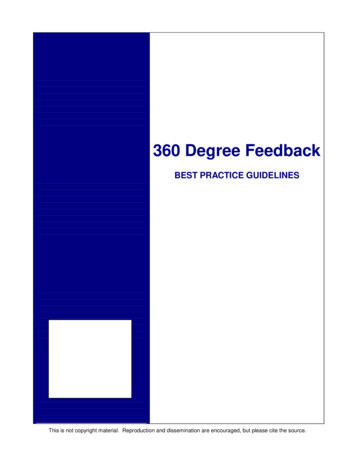
Transcription
360 Degree FeedbackBEST PRACTICE GUIDELINESThis is not copyright material. Reproduction and dissemination are encouraged, but please cite the source.
Contributing Organisations1Background2Overview3360 iew55555PlanningEstablishing the purposeEstablishing the processEstablishing the Review14Acknowledgements16Further Reading17
These guidelines were produced with the active support andfunding of the following organisations: Chartered Institute of Personnel andDevelopment, South West London Branch SHL The British Psychological Society The Department of Trade and Industry University of Surrey RoehamptonThe following contributed to the development of the guidelines:Áine Gray, SHLAntonia Lewis, SHLClive Fletcher, BPS, Division of Occupational PsychologyEugene Burke, SHLJohn Mackay, Small Business Service,Department of Trade and IndustryMark Kubilius, Management Best Practice Directorate,Department of Trade and IndustryPat Lindley, BPS Steering Committee on Test Standards1
“The concept of 360 degree feedback makes a lot of sense and, if usedwell, should have a great deal to offer. It seems to suit the movetowards the less hierarchical, more flexibly-structured and knowledgebased organisations of the future”Professor Clive FletcherGoldsmiths College, University of LondonIn today’s changing and volatile world organisations are continuallylooking for ways to improve performance, and satisfy the demands ofall stakeholders. Achieving this almost inevitably involves change,which then becomes the pivotal dynamic for success.For an organisation to evolve the people working within it will have toadapt; and for this to be successful, they first of all need to know whatit is about the way they are currently performing that needs to change.This is where 360 degree feedback is playing a growing role inorganisations through its ability to provide structured, indepthinformation about current performance and what will be required of anindividual in the future to enable detailed and relevant developmentplans to be formulated.Professionally managed, 360 degree feedback increases individualself-awareness, and as part of a strategic organisational process canpromote:§ Increased understanding of the behaviours required to improveboth individual and organisational effectiveness§ More focused development activities, built around the skills andcompetencies required for successful organisational performance§ Increased involvement of people at all levels of the organisation§ Increased individual ownership for self-development and learning§ Increased familiarity with the implications of cultural or strategicchange· These guidelines set out issues, and recommendations for action,that should be considered when implementing a 360 degreeprogramme. They have been developed by the contributingorganisation in order to support and encourage best practice in thearea. These guidelines are also available at www.dti.gov.uk/mbp.2
360 degree feedback is a process whereby an individual (the recipient)is rated on their performance by people who know something abouttheir work (the raters). This can include direct reports, peers andmanagers and in some cases customers or clients, in fact anybodywho is credible to the individual and is familiar with their work can beincluded in the feedback process. This is usually in addition tocompleting a self-assessment on performance. The resultinginformation is presented to the individual with the aim of helping themto gain a better understanding of their skills and development areas.Each source can provide a different perspective on the individual’sskills, attributes and other job relevant characteristics and thus help tobuild up a richer, more complete and accurate picture than could beobtained from any one source.How does 360 degree feedback compare toother organisational interventions?As a process, 360 degree feedback sits alongside a number of otherprocesses used in organisations to harness the potential of individuals.Indeed, although not intended to replace any of these processes, itdoes draw on specific strengths of each, bringing them together in anew form.Assessment and Development Centresq 360 degree feedback builds on the principles of structured andrigorous assessment against competencies, which is the core ofassessment and development centres.Employee Surveysq 360 degree feedback draws on the principles of wider involvementand consultation evident in employee attitude and opinion surveys,but with a focus on individual performance rather thanorganisational culture and climate.Performance Appraisalsq 360 degree feedback builds on the principle of regular feedback onperformance evident in performance appraisals, but because awider range of people are involved can be seen as fairer and morecredible.Coaching, Counselling and Career Development Interventionsq Fundamental to 360 degree feedback is the objective of increasingself-awareness, which is one of the key objectives of coaching,counselling and career development activities.3
360 degree feedback, also known as multi-level, multi-sourcefeedback, is a very powerful and sensitive process. It can increase theindividual’s awareness of how their performance is viewed by theircolleagues and indeed how it compares with their own view of theirperformance. It can serve as a strong spur for development andbehaviour change. Its very power means that it needs to be managedprofessionally. There can be costs, both for the individual and theorganisation in getting it wrong.These guidelines have been written to provide a framework forintroducing and managing 360 degree feedback. The guidelines offerchecks and balances to consider, to ensure the process workseffectively and fairly, avoiding some of the potential costs.The diagram below gives an overview of the critical stages in managinga 360 degree process and the rest of the guidelines provide more detailunder each of the headings. This information is summarised in achecklist on the following page.4
Establishing the purposeq q Does the organisational culture support the introduction of 360degree feedback?Are the purpose and objectives clear?Establishing the processq q q q q q Is there senior management commitment?Have those taking part been involved at the planning stage?Has a clear process for identifying the raters been agreed?Does the questionnaire relate to job performance and describerelevant behaviours?Is it a reliable and valid instrument?Is the feedback presented in a useful and sensitive way?Establishing resourcesq q q q q q q q q q q q q q q q q Have the resources for subsequent development been consideredat the planning stage and is there an appropriate balance betweenthe resources devoted to development and those to implementingthe 360 degree feedback?Where computers are being used, has the security of the systembeen considered?Is the questionnaire meeting its purpose?If it has not been used before, is it reliable and valid?Are the resource estimates for the rollout realistic?Is there clear communication to all involved?Is there a clear owner responsible for administering the process?Is there a “helpline” or clear point of contact?Are the deadlines clear and who monitors whether they are beingmet?How are the raters being briefed?Have those giving the feedback been trained in the relevant skills?Will the feedback be communicated face-to-face?Is there appropriate support for those receiving the feedback?Has appropriate and sensitive timing been considered as part ofthe process?Has the review process been considered at the planning stage?Has the 360 degree feedback met its purpose?Has it resulted in improvement in performance?5
What are the issues to be considered when an organisation ispreparing to introduce 360 degree feedback? These can be dividedinto three main areas: Establishing the purposeEstablishing the process Establishing resourcesEstablishing the purpose The culture of an organisation needs to be considered prior to theintroduction of the 360 degree feedback process. It is more likelyto be easily introduced where openness, mutual trust and honestyare part of the organisational culture and there is a genuineinterest in and desire for performance improvement. The adoptionof a full 360 degree approach needs to stem from a steadyevolution in appraisal and development practices. It is very unlikelythat a 360 degree scheme would be accepted where there is nohistory of systematic feedback on performance. It would presenttoo radical a step. 360 degree processes with a clear purpose and objectives arelikely to be more effective, particularly when they are aligned withorganisational strategies and goals and can be linked to existingprocesses within the organisation.Development or performance appraisal The purpose of feedback, whether it is purely for development oras part of a performance appraisal process, will influenceimplementation decisions. Detailed discussion of this area isbeyond the scope of this document, and more in-depthconsideration can be found in the articles and books included inthe further reading sections of these guidelines. Research to datehas indicated that the use of 360 degree feedback as part ofperformance appraisal has had mixed success. In mature andopen organisational cultures, with a strong performance appraisalsystem already in place, the use of 360 degree feedback in thisway may be appropriate. Where this is the case, some of thedecisions at the planning stage will be affected. For example;§ participation in the process is likely to be mandatoryrather than voluntary§ it is likely to be carried out annually§ the decision on who is to contribute may not be leftsolely to the individual§ the individual’s manager is more likely to beinvolved in follow-up action§ decisions on how it links to reward need to be clear. 360 degree processes with a clear purpose and objectives arelikely to be more effective, particularly when they are aligned withorganisational strategies and goals and can be linked to existingprocesses within the organisation.6
Establishing the processGaining commitment Commitment from senior management is a key influence onwhether 360 degree feedback is seen as credible within theorganisation. A ‘top-down’ approach, with senior managersreceiving feedback on their own performance is one way ofachieving this. There is evidence to suggest that seniormanagement commitment can be gained through witnessing thesuccess of the system in one part of the organisation, if their directinvolvement is not possible at the outset.A powerful way of gaining commitment to the introduction of 360degree is to consult with participants who will be involved in thescheme, raters as well as recipients. For example, how thescheme should be structured and operated, and aspects of itscontent. It is only by following that kind of approach that fears arelikely to be allayed and enough trust built up to let the schemeflourish.The raters Identifying the most appropriate people to rate the performance ofthe individual is a key part of the process. Ideally the recipient willhave full involvement in identifying who they think is in the bestposition to comment on their performance. The raters must becredible to the recipient for them to act on the resulting feedback.A frequent concern is that the person being rated may respondnegatively to the information and may take it out on their raters.To minimise this concern, most feedback schemes promiseanonymity for the raters.The number of raters is important on two counts. First, theassessment has to be based on a large enough sample to ensurethat it is valid; if it is too small, there is a danger that one rater’sview will have a major impact on the overall results. Second, thesample of raters needs to be large enough that individual sourcescannot be identified; a minimum of three to five people, dependingon the circumstances. The implications for time and administrativeeffort involved are clear. Where there are fewer than three to fivepeople available, it may be necessary to combine groups, forexample, direct reports and peers to ensure confidentiality.Once a decision is made on who has access to the ratings, thisneeds to be adhered to consistently through the life of the process.A change in who has access to the information is one of the mostcommon reasons for lack of trust in the process. If there are goodreasons to change, it is critical to seek the permission of theindividuals involved before making that change.7
The questionnaire The instrument used in a 360 degree feedback process needs todescribe the behaviours which relate to actual job performance. Italso needs to be a reliable measurement tool. The further readingsection at the end of this document contains references whichdiscuss the questions of reliability and validity in more detail.Whether the same instrument is used across the organisation orfor different job roles will depend on how relevant the behavioursare for the different groups involved. The instrument needs todescribe specific work behaviours and ideally relate to existingmeasurement systems within the organisation, for example,competencies. It also needs to be in line with the organisation’sculture and values.The questionnaire needs to be relevant to the raters and their dayto day involvement with the individual.A well-designed questionnaire should offer respondents theopportunity to indicate where they have not had the opportunity toobserve a behaviour, or where the behaviour is not relevant to thejob, so as not to force them to guess.While the majority of 360 degree feedback processes involve theuse of a questionnaire, it is possible to run very effectiveprogrammes without the use of questionnaires. However, theseprogrammes need to be managed with extreme caution andrequire a mature organisational culture and the support of a goodfacilitator.The structure of feedback Another issue for consideration is the format for the feedback.Feedback can be provided through aggregating the ratings andpresenting an average ‘score’ on each question, perhaps puttingthe self-rating alongside it. While this preserves anonymity, itdoes have the disadvantage of failing to identify importantdifferences in perspective. Ideally, the ratings of the differentgroups are presented separately, and the range of the ratings (i.e.highest and lowest) as well as the averages included so that thesedifferences in perspective are identified. If there are enough ratersinvolved, this should not compromise anonymity. The feedbackshould also be reviewed for sensitivity in how the information onthe ratings is presented and in particular how the implications oflower ratings are conveyed.Some questionnaires include a free-written section in which otherobservations or comments may be made. This can help to throwmore light on the ratings, but again the person giving the feedbackneeds to be sensitive in managing this information.8
Establishing the resources When planning a 360 degree feedback process, it is important tohave an accurate view of the time and resource needed to roll itout effectively. This includes the time needed to set up andmanage the programme, the administrative time in gathering thefeedback and compiling reports, the time needed for thoseproviding the feedback and the time and resource involved ingiving that feedback to the individual and in supporting subsequentaction.Resources for development Where 360 degree feedback is being used to encouragedevelopment, it is important to have considered in advance theresources needed to support such activity. It is very easy toconcentrate on the mechanics of organising the process and losesight of the original purpose of the feedback. The gathering of the360 degree information is just the starting point in the developmentcycle. Considering the resources for subsequent developmentactivity early in the process will help keep a focus on the overallobjective. The feedback will provide a new understanding ofdevelopment needs, but if there are no resources available toaddress these needs, it will be a frustrating experience for thoseinvolved.The role of technology in 360 degree feedback Increasingly, computers are used to support 360 degree feedbackprocesses, and have considerable advantages in reducing theadministration and in gathering feedback where people work ondifferent sites and in different countries. When gatheringinformation in this way, particularly where the internet is themedium, it is important to ensure the process is secure and thatthe information will remain confidential to the agreed peopleinvolved in the process.9
Piloting is critical in 360 degree feedback. It helps remove some of theuncertainties through allowing a group to experience the process. Itprovides useful information for further planning and communication.Piloting also allows for a review of the 360 degree instrument. Ideally, the pilot group would have a positive attitude generally to360 degree feedback and be willing to be open-minded and honestin their evaluation of how it worked. Reviewing the effectiveness of the 360 degree instrument used isvery important in the early stages of introducing the process.Consider the following:§ Is the feedback shaded too positively?§ Are appropriate development actions identified?§ Is the questionnaire user-friendly?§ Is the questionnaire relevant to the jobs of those taking part? The technical qualities of the instrument are important. If there isgood evidence available that it is reliable and valid, this may be lessrelevant, but if this is the first use of the instrument, or it has beendesigned specifically for this application, checking the technicalqualities becomes more important. Areas to consider here are:§ The extent to which it is reliable.§ The extent to which the items actually relate to the competencyor area being assessed.§ The appropriate minimum number of items have been includedto achieve the purpose of the exercise. The numbers to be included in the pilot will be influenced by theneed to technically review the instrument. For further guidance ondesigning reliable and effective instruments refer to FurtherReading at the end of these guidelines.Monitoring resource requirements Undertaking a pilot generates a realistic picture of the resourcesrequired to manage the process throughout the rest of theorganisation. As well as administration time, valuable insights canbe gained into the time required for those rating performance andthose who are receiving feedback. A pilot also provides a realisticpicture of how soon the feedback can be given to participants.Confidentiality The confidentiality of the information for those taking part in thepilot will help to highlight some of the issues for subsequent roll-out.Clear information about who will have access to the pilot data is asimportant at this stage as it is throughout the process.10
When it comes to the implementation stage of the programme, all ofthe lessons learned through the pilot should be considered. Anyalterations and adaptations that will make implementation smoothershould be made.The most critical part of the implementation process is ensuring thateverybody involved in the process is clear about what it involves andtheir specific role(s).To ensure this occurs: Clear and positive communication is pivotal. A point of contact for participants to refer to can help the roll outprocess, for example a ‘helpline’ for queries and concerns. It is beneficial to pinpoint an individual, or team, to take onresponsibility for the administration of the system – this helpsensure that the procedure is running smoothly and any issues areresolved swiftly. One of the key roles of the administrator is to ensure people withlow returns, either the person being rated or the people who aredoing the rating, are followed up, and are completing thequestionnaires. This is to keep up the momentum and is critical tothe success of implementation. Technology based systems canhelp to reduce the workload involved in this. Deadlines need to be established and communicated to allparticipants, including information on when and how recipients willreceive feedback. Constant monitoring of completion rates is recommended, this willhelp ensure that timescales are met.Evidently briefing those who will receive feedback is crucial. It is alsoimportant to consider briefing the raters on the objectives of thescheme and some basic tips for completing the questionnaire, forexample highlighting the importance of marking observed behaviourrather than ‘gut feel’.It is also necessary to consider, ideally prior to implementation, theresource implications of providing feedback. Setting out a timetablemonitoring questionnaire completion and provision for feedback canhelp ensure that realistic timescales are set at the beginning of theprogramme.11
Feedback is an integral part of any management process, not just 360degree processes. The starting point for any subsequent action is theeffective communication of the results of the exercise to the personreceiving the feedback. How this is done, and by whom, will beinfluenced by the purpose of the exercise. Effective feedback is thespringboard for subsequent development and is integral to the successof the process.How will the feedback be communicated? The first question is whether the information is communicated faceto-face to the individual involved, with the support of a facilitator, orwhether the feedback is delivered via a report, without theinvolvement of a facilitator. Given that an individual is receiving sensitive information about howtheir colleagues, direct reports and manager view theirperformance, sensitivity is required. Best practice would be tomake someone available to help interpret the results with thatperson. Where face-to-face feedback is included in the programme, thepeople giving the feedback will need to have the skills to supportthis process. Training of feedback facilitators is an important part ofthe implementation. The facilitators need a good understanding ofthe organisation’s policies on 360, close familiarity with bothinstrument and report, an awareness of the range of reactionsindividuals have to feedback, interpersonal skills in conducting afeedback session, and to be seen as trustworthy and credible. Where 360 degree feedback is being given for development,discussion of the results with the facilitator can help focus thediscussion on future development planning rather than focusing onthe feedback itself. Skilled facilitators will help the individual todraw out evidence and make connections across different peopleand situations. It is this process that stimulates self-awareness andmakes 360 degree feedback such a powerful process. In cases where there is a more open organisational culture, theindividual receiving the feedback might be encouraged to explorethe meaning of the results with those providing the feedback. Thiscan be invaluable in removing any ambiguity about the feedback aswell as being a good starting point for subsequent development. Itrequires the support of a facilitator to ensure that the process ismanaged effectively and sensitively.12
When will the feedback be communicated? Ideally the 360 degree process would be designed so that theindividual receives feedback as soon as possible after thatfeedback was given. Having shorter turn-around times maintainsthe momentum of the process as well as motivation for theindividual. Given the pace of change in many organisations,shorter turn-around times will ensure that the feedback is stillrelevant for the role. When planning the timing of the feedback, it is important to ensurethat people receive it when there is support available to interpret theresults. Providing a report without support, particularly prior to aweekend or going on holidays, is far from ideal, and can havestrong negative consequences. If the feedback facilitators do a number of feedback sessions, theycan provide very valuable information about the themes across thesessions. This would evidently need to be done withoutcompromising individual confidentiality. This information could feedinto the management development process to help tackle some ofthe wider organisational issues.13
Reviewing the success of the programme is a widely overlooked part ofthe implementation process. Too often, organisations assume that byintroducing a process it will automatically by a success. The keyquestion, is whether the 360 degree feedback met its original purpose.If the original purpose was to improve performance, have relevantdevelopment needs been identified? If it was to support theperformance appraisal process, has the process supplied the requiredinformation in a fair and credible way?From an organisational perspective, if the 360 degree process isrepeated, an invaluable indicator of the effectiveness of the process isthe extent to which the ratings of performance improve over time.However, it is useful, from an individual perspective, to make peopleaware that while their performance might improve, their ratings mightnot fully reflect the degree of improvement that they have made. Thisis because the very fact of doing 360 degree feedback raisesexpectations and increases knowledge of expected behaviour. Thisdynamic means that individuals are unlikely to become complacent, butit needs to be managed carefully.Planning By considering the review at the planning stage, it is possible tointroduce measures to gather feedback on the wider process as itis being rolled out. Following the pilot, this can be done in astructured way through feedback forms, although care needs to betaken in not adding too much to the burden of form filling.Qualitative Review Once the process has been rolled out, a qualitative review with thekey people involved will provide invaluable information on whether ithas met its purpose. This includes those receiving feedback, thosedoing the rating, those facilitating the feedback and the linemanagers of those involved. It might also be appropriate to gathera more strategic view of the impact of the feedback. The timing ofthe review will depend on the original purpose, with more timeneeded when the purpose was development. Practicality is veryrelevant at this stage of the review:Does the programme allow raters sufficient time to complete thequestionnaires?How easy is it to manage the feedback process?How comfortable are recipients with the feedback given?14
The Questionnaire While the technical qualities of the instrument will be examined inthe pilot, greater numbers will be available once the process hasbeen rolled out. The key question here is does the questionnairemeasure what it set out to measure?- is it consistent with and link to other relevant indicators ofperformance in the organisation?- do individuals gather development information?- do raters use the rating system effectively?- is it reliable?- does it ‘look’ right?The aggregate data from the questionnaires can provide usefulinformation in identifying patterns of strengths and developmentneeds across the participating group. This information can be usedto feed into development planning at a strategic level, to ensurethat the organisation has people with the relevant skills to meet itsobjectives.15
The original idea of developing Best Practice Guidelines in 360 degreefeedback developed from a collaborative research project, TheFeedback Project. This project was sponsored by the organisationssupporting the guidelines and the Project Director was ProfessorChristine Farrell, whose influence in stimulating the production of theseguidelines is very gratefully acknowledged.The original Feedback Project team was made up of:Áine Gray – SHLAngela Stewart – SHLBryan Anderson – CIPD South West London BranchChris Handley – CIPD South West London BranchDiane Bray – University of Surrey RoehamptonPhilip Darling – University of Surrey RoehamptonWendy Chivers– University of Surrey RoehamptonThe full report on The Feedback Project research can be accessed atthe University of Surrey Roehampton website:www.roehampton.ac.uk/social/bct and the CIPD South West LondonBranch website: http://branchwebs.cipd.co.uk/swlondon.In developing the guidelines, Professor Farrell interviewedrepresentatives of the organisations listed below, whose input wasmuch appreciated:Angela Brown, Personnel Decisions InternationalClive Fletcher, BPS, Division of Occupational PsychologyEugene Burke, SHLIngrid Manning, Oxford Psychologists PressPatricia Hind and Jackie Ashtown, Ashridge Management CollegeValerie Garrow, Roffey Park Management Institute16
Alimo-Metcalfe, B. (1998). 360 Feedback and LeadershipDevelopment. International Journal of Selection and Assessment, 6,35-44.Armstrong, M. and Baron, A. (1998). Performance ManagementFeature: Out of the tick box. People Management, 23 July, 38-41.Chivers, W. and Darling, P. (1999) 360 Degree Feedback andOrganisational Culture. Institute of Personnel and Development,London.Fletcher, C. (1998) ‘Circular Argument’ People Management, 1stOctober, 46-49.Fletcher, C (1997) Appraisal: Routes to Improved Performance.Institute of Personnel and Development, London.Fletcher, C. (1997) Self awareness – a neglected attribute in selectionand assessment? International Journal of Selection and Assessment,vol 5, 183-187.Fletcher, C., Baldrey, C., & Cunningham-Snell, N. (1998). Thepsychometric properties of 360 degree feedback; an empirical studyand a cautionary tale. International Journal of Selection andAssessment, vol 6, 19-34.Fletcher, C. and Baldry, C. (1999). Multi-source feedback systems: aresearch perspective. In C.L. Cooper and I.T. Robertson (Eds.)International Review of Industrial and Organizational psyc
q 360 degree feedback builds on the principle of regular feedback on performance evident in performance appraisals, but because a wider range of people are involved can be seen as fairer and more credible. Coaching, Counselling and Career Development Interventions q Fundamental to 360 degree feedback is the objective of increasing
